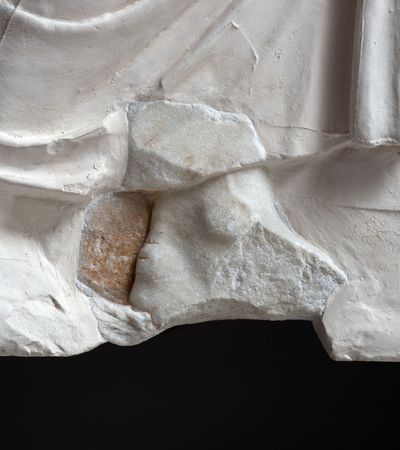Parthenon. East frieze. Block 6 (VI)
Inventory number
Ακρ. 856
Artist
Pheidias' workshop
Category
Architectural sculpture
Period
Classical Period
Date
442-438 BC
Dimensions
1.01 x 4.17 x 0.48 m
Left part of block: 1.01 x 1.31 x 0.48 m
Fragment of Artemis’ feet and garment: 0.355 x 0.31 x 0.105 m
Fragment of Artemis' garment: 0.18 x 0.1 x 0.09 m
Fragment of Aphrodite's dressed hand: 0.28 x 0.19 x 0.09 m
Fragment of Aphrodite's garment and seat: 0.33 x 0.29 m
Fragment of Aphrodite's head: 0.1 x 0.15 x 0.05 m
Fragment of Aphrodite's garment: 0.11 x 0.1 x 0.04 m
Upper right part of block with a teletarch's head: 0.14 x 0.52 x 0.155 m
Fragment of teletarch's foot: 0.12 x 0.13 x 0.05 m
Material
Marble from Penteli
Location
Parthenon Gallery
The left half of Block VI that adjoins the plaster cast of the original half right, exhibited today in the British Museum in London. On the plaster copy some original fragments have been adjusted, among which one with Artemis feet that was returned from the A. Salinas Museum in Palermo, Sicily and was permanently joined on the cast in June 2022. The sawing of the right part of the block was probably caused by Thomas Bruce, the lord of Elgin in order to easily transport it to London.
On the left side of Block VI, four deities seated comfortably on stools engage in conversation having turned their back to the central scene of the dedication of the Panathenaic peplos depicted on Block V (Ακρ. 855). The first from the left is Poseidon. Next to him are seated Apollo, his sister Artemis and Aphrodite. Little Eros rests his right hand on his mother’s, Aphrodite, knees whereas in his other hand holds a parasol to protect her delicate skin from the sun. Eros’ figure is not preserved, however, we know about his posture thanks to a plaster copy of Block VI commissioned in 1787 for Auguste de Choiseul-Gouffier.
The right part of Block VI depicts four male figures: one beardless youth and three older bearded men leaning on their staffs, usually recognised as Eponymous Heroes of Attica. The last two figures on the block with their himatia wrapped around their waist are interpreted as parade marshals (teletarches) who receive and make signals to the women’s procession of the Panathenaic festival approaching from the (Ακρ. 1258).
The frieze on the east side of the Parthenon shows the arrival on the Acropolis of the procession formed by the people of Athens during the festival of the Panathenaia in honour of the protectress of the city, Athena. The procession’s destination was the Temple of Athena Polias. Its purpose was the transportation of the Panathenaic peplos destined to adorn the age-old xoanon of the goddess and the offer of a grand sacrifice of animals at the Great Altar outside of the temple.
The converging groups of women from both sides of the east frieze hold ritual vessels and are received by supervisors. The central scene, right above the temple's entrance, depicts the giving of the Panathenaic peplos and takes place in the presence of the Olympian gods who are rendered at a larger scale than the mortals. The gods are flanked with ten male figures, possibly the Eponymous Heroes of Attica, the mythical progenitors of the Athenian tribes.
The east frieze is relatively well preserved as the explosion of the Parthenon by the Venetians under the command of the general Francesco Morosini, in 1687, did not cause many damages on this side of the temple. The drawings attributed to the painter Jacques Carrey, who visited the Acropolis in 1674, just thirteen years before the bombardment by Morosini, help our understanding of a few missing parts of this side of the frieze.
The total length of the east frieze is 21.18 m. It is formed of eight blocks, but sometimes scholarly work refers to nine blocks as one of the slabs was initially treated as being ma
Michaelis, Α., Der Parthenon, Leipzig, 1870-1871, σελ. 203-228:1-26, 232-234, 251-252, 259, πίν. ΧΙV, αρ.κατ. Platte VΙ
Amelung, W., «Frammento del fregio del Partenone», Mitteilungen des Deutschen Archäologischen Instituts. Römische Abteilung VIII, 1893, σελ. 76-78
Smith, A.H., British Museum. The Sculptures of the Parthenon, London, 1910, σελ. 54-55, εικ. 102-103, πίν. 36-38
Casson, S., Brooke, D., Catalogue of the Acropolis Museum. Sculpture and Architectural Fragments, with a section upon the Terracottas, II, Cambridge, 1921, σελ. 105-106, εικ. 856, αρ.κατ. 856
Curtius, L., «Zu Phidias. Ein biographischer Beitrag by Heinrich Sitte; Die Kunst des Phidias by Anton Hekler; Phidias and the Parthenon Sculptures by P. Johansen, Ingeborg Andersen», Gnomon 2, 1926, σελ. 24
Schuchhardt, W.H., «Die Entstehung des Parthenonfrieses», Jahrbuch des Deutschen Archäologischen Instituts 45, 1930, σελ. 220-230, εικ. 1, 31-36, 38-40
Lippold, G., Die griechische Plastik, Handbuch der Archäologie III 1, München, 1950, εικ. 53.1
Fehl, P., «The Rocks on the Parthenon Frieze», Journal of the Warburg and Courtauld Institutes 24, No. 1/2 (Jan. - Jun), 1961, σελ. 12, 28, πίν. 4a
Jeppesen, K., «Bild und Mythus an der Parthenon. Zur Ergänzung und Deutung der Kultbildausschmückung, des Frieses, der Metopen und der Giebel», Acta Archaeologica 34, 1963, σελ. 30, εικ. 6d
Bowie, Th., Thimme, D. (εκδ.), The Carrey Drawings of the Parthenon Sculptures, Bloomington, Indiana University Press, 1971, σελ. 55, 70-71, πίν. 27-28
Δεσπίνης, Γ., «Ένα νέο θραύσμα από την ανατολική πλευρά της ζωφόρου του Παρθενώνα», στο Δ. Παντερμαλής, Κ. Ρωμιοπούλου, Χ. Μαυροπούλου-Τσιούμη (επιμ.), Κέρνος. Τιμητική προσφορά στον καθηγητή Γεώργιο Μπακαλάκη, Θεσσαλονίκη, 1972, σελ. 35-42, εικ. 16.2
Μπρούσκαρη, Μ., Μουσείον Ακροπόλεως. Περιγραφικός κατάλογος, Αθήνα, 1974, σελ. 157-158, εικ. 302, αρ.κατ. 856
Brommer, F., Der Parthenonfries, Mainz, 1977, σελ. 117-121, εικ. 178-185, 189.1, αρ.κατ. O VI 38-48
Boardman, J., «The Parthenon Frieze - Another View», στο U. Höckmann, A. Krug (επιμ.), Festschrift für. Frank Brommer, Mainz, 1977, σελ. 46
Παλαγγιά, Ό., Ο γλυπτός διάκοσμος του Παρθενώνα, Αθήνα, 1983, σελ. 64-65
Beschi, L., Il fregio del Partenone: una proposta di Lettura, Atti della Accademia Nazionale dei Lincei, serie 8. Rendiconti, Classe di Scienze morali, storiche e filologiche 39, 1984, σελ. 188-189, εικ. VIII
Boardman, J., Finn, D., The Parthenon and its Sculptures, London, 1985, σελ. 239, 245
Beschi, L., «Η Ζωφόρος του Παρθενώνα. Μια νέα πρόταση ερμηνείας», στο H. Kyrielies (επιμ.), Archaische und klassische griechische Plastik, Τόμος 2. Akten des internationalen Kolloqiums vom 22- 25. April 1985 in Athen, Rheim am Mainz, 1985, σελ. 220, εικ. 9
Boardman, J., Greek Sculpture. Τhe Classical Period. A Handbook, London, 1985, εικ. 94
Wesenberg, B., «Panathenäische Peplosdedikation und Arrhephorie. Zur Thematik des Parthenonfrieses», Jahrbuch des Deutschen Archäologischen Instituts 110, 1995, σελ. 150, 156-7, 176-178, εικ. 2
Berger, Ε., Gisler-Huwiler, M., Der Parthenon in Basel. Dokumentation zum Fries, Mainz, 1996, σελ. 161-166, εικ. 135-138, αρ.κατ. OST VI 38-48
Harrison, E.B., «The Web of History: A Conservative Reading of the Parthenon Frieze», στο J. Neils (επιμ.), Worshipping Athena. Panathenaia and the Parthenon, Wisconsin, United States, 1996, σελ. 209-210
Pollitt, J., «The Meaning of the Parthenon Frieze», στο D. Buitron-Oliver (επιμ.), The Interpretation of Architectural Sculpture in Greece and Rome, Washington, 1997, σελ. 51-65
Τριάντη, Ι., Το Μουσείο Ακροπόλεως, Ο Κύκλος των Μουσείων, Αθήνα, 1998, σελ. 251-252, 318-323, εικ. 324, 325-329
Neils, J., «Reconfiguring the Gods on the Parthenon Frieze», The Art Bulletin 81, 1999, σελ. 8-11
Boardman, J., «The Parthenon Frieze, a Closer Look», Revue Archéologique Fasc. 2, 1999, σελ. 325-330
Lagerlöf, M.R., The Sculptures of the Parthenon. Aesthetics and Interpretation, Yale, 2000, σελ. 20-24, 46-48, 60-79
Neils, J., The Parthenon Frieze, New York, 2001
Jenkins, I., The Parthenon Frieze, 2nd edition, London, 2002, σελ. 80
Stevenson, T., «The Parthenon Frieze as an idealized, contemporary Panathenaic festival», στο D.J. Phillips, D. Pritchard (επιμ.), Sport and Festival in the Ancient Greek World, Wales, 2003, σελ. 255, 257, 259, 260, εικ. 8
Symeonoglou, S., «A new analysis of the Parthenon Frieze», στο M.B. Cosmopoulos (επιμ.), The Parthenon and its sculptures, Cambridge, 2004, σελ. 5-10, 36-41, εικ. 1.1-1.6
Younger, J.G., «Work Sections and repeating patterns in the Parthenon Frieze», στο M.B. Cosmopoulos (επιμ.), The Parthenon and its sculptures, Cambridge, 2004, σελ. 63-68, 82-83
Trianti, I., «Sculpture in Athens, Sixth-Fifth Century B.C.», στο N. Kaltsas (επιμ.), Athens-Sparta, Onassis Cultural Center, New York, December 6, 2006 - May 12, 2007, New York, 2006, σελ. 80, εικ. 5
Jeppesen, K., «A fresh approach to the problems of the Parthenon Frieze», στο E. Hallager, J.T. Jensen (επιμ.), Proceedings of the Danish Institute at Athens V, Athens, 2007, σελ. 103, 133, 166, 169, εικ. 1, 24b
Pollini, D., «Christian Destruction and Mutilation of the Parthenon», Mitteilungen des Deutschen Archäologischen Instituts. Athenische Abteilung 122, 2007, σελ. 219, 222-224, εικ. 33-34
Patay-Horváth, A., Metallanstückungen an griechischen Marmorskulpturen in archaischer und klassischer Zeit, Tübinger Archäologische Forschungen 4, 2008, σελ. 81-82, εικ. 54-55, αρ.κατ. 33
Wrede, H., Das Lob der Demokratie am Parthenonfries, Trierer Winckelmannsprogramme 21, 2008
Neer, R., The Emergence of the Classical Style, Chicago/London, 2010, εικ. 134
Ellinghaus, C., Die Parthenonskulpturen. Der Bauschmuck eines öffentlichen Monumentes der demokratischen Gesellschaft Athens zur zeit des Perikles -Techniken in den bildenden Kunst zur Tradierung von Aussagen, Hamburg, 2011, σελ. 117-118, 128, 129, 131, εικ. 193, 194
Schwab, K., «Drawing the Parthenon Sculpture», στο G.S. Bucher, J. Deupi (επιμ.), An Archaeologist's Eye. The Parthenon Drawings of Katherine A. Schwab, Fairfiled, 2014, σελ. 21
Bucher, G.S., Deupi, J. (επιμ.), An Archaeologist's Eye: The Parthenon Drawings of Katherine A. Schwab, Consulate General of Greece in New York City, January 16 - March 7, 2014 and 6 other locations, Fairfiled University, 2014, αρ.κατ. 31-33
Borbein, A.H., «Die Skulpturen des Parthenon: Wie vollzieht sich Stilentwicklung?», Jahrbuch des Deutschen Archäologischen Instituts 131, 2016, σελ. 107, 109-111, 118-126, εικ. 6d
Osada, T., «The Parthenon Frieze - Display of Piety and Privilege», στο T. Osada (επιμ.), The Parthenon Frieze. The Ritual Communication between the Goddess and the Polis, Parthenon Project Japan 2011-2014, Wien, 2016, σελ. 11-30
Nakamura, T., «The Clothing and Armour of the Horsemen and Warriors on the Parthenon Frieze», στο T. Osada (επιμ.), The Parthenon Frieze. The Ritual Communication between the Goddess and the Polis, Parthenon Project Japan 2011-2014, Wien, 2016, σελ. 61-82
Nakamura, R., «A 3-D Recreation of the Gods on the Parthenon Frieze. The Bodies and Space of the "Invisibles"», στο T. Osada (επιμ.), The Parthenon Frieze. The Ritual Communication between the Goddess and the Polis, Parthenon Project Japan 2011-2014, Wien, 2016, σελ. 52-53
Shinozuka, C., «Myth and Ritual. The Garments of the Maidens on the Parthenon Frieze», στο T. Osada (επιμ.), The Parthenon Frieze. The Ritual Communication between the Goddess and the Polis, Parthenon Project Japan 2011-2014, Wien, 2016, σελ. 91-117, εικ. 4-5
Tanaka, E., «The Concept of Space in the Parthenon Frieze», στο T. Osada (επιμ.), The Parthenon Frieze. The Ritual Communication between the Goddess and the Polis, Parthenon Project Japan 2011-2014, Wien, 2016, σελ. 119-138
Παντερμαλής, Δ., Ελευθεράτου, Σ., Βλασσοπούλου, Χ., Μουσείο Ακρόπολης. Οδηγός, Αθήνα, 2016, σελ. 232, 236-237, εικ. 287, 289-290
Meyer, M., Athena, Göttin von Athen. Kult und Mythos auf der Akropolis bis in klassische Zeit, Wien, 2017, σελ. 99-100, 104-107
Korka, E., Fragments of the Parthenon Sculptures displayed in Museums across Europe (with the exception of the British Museum and the Acropolis Museum), Athens, 2017, σελ. 53-56, εικ. 43-44
Holtzmann, B., «Pittakis, Michaelis, Athanasiou. À propos de quelques blocs de la frise du Parthénon», στο H.-R. Goette, I. Leventi (επιμ.), Excellence Studies in Honor of Olga Palagia, Studia Honoraria, Band 38, Rahden, 2019, σελ. 77-78, εικ. 6, αρ.κατ. 9
















